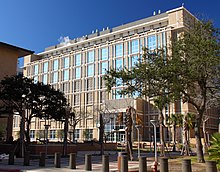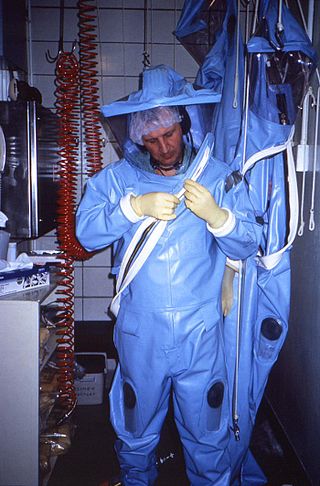
Biosafety is the prevention of large-scale loss of biological integrity, focusing both on ecology and human health. These prevention mechanisms include the conduction of regular reviews of biosafety in laboratory settings, as well as strict guidelines to follow. Biosafety is used to protect from harmful incidents. Many laboratories handling biohazards employ an ongoing risk management assessment and enforcement process for biosafety. Failures to follow such protocols can lead to increased risk of exposure to biohazards or pathogens. Human error and poor technique contribute to unnecessary exposure and compromise the best safeguards set into place for protection.

The National Institutes of Health, commonly referred to as NIH, is the primary agency of the United States government responsible for biomedical and public health research. It was founded in the late 1880s and is now part of the United States Department of Health and Human Services. Many NIH facilities are located in Bethesda, Maryland, and other nearby suburbs of the Washington metropolitan area, with other primary facilities in the Research Triangle Park in North Carolina and smaller satellite facilities located around the United States. The NIH conducts its own scientific research through the NIH Intramural Research Program (IRP) and provides major biomedical research funding to non-NIH research facilities through its Extramural Research Program.
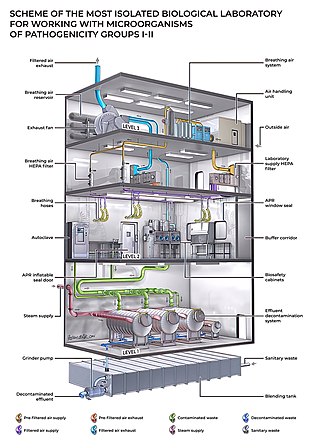
A biosafety level (BSL), or pathogen/protection level, is a set of biocontainment precautions required to isolate dangerous biological agents in an enclosed laboratory facility. The levels of containment range from the lowest biosafety level 1 (BSL-1) to the highest at level 4 (BSL-4). In the United States, the Centers for Disease Control and Prevention (CDC) have specified these levels in a publication referred to as BMBL. In the European Union, the same biosafety levels are defined in a directive. In Canada the four levels are known as Containment Levels. Facilities with these designations are also sometimes given as P1 through P4, as in the term P3 laboratory.

A biological hazard, or biohazard, is a biological substance that poses a threat to the health of living organisms, primarily humans. This could include a sample of a microorganism, virus or toxin that can adversely affect human health. A biohazard could also be a substance harmful to other living beings.

Fort Detrick is a United States Army Futures Command installation located in Frederick, Maryland. Fort Detrick was the center of the U.S. biological weapons program from 1943 to 1969. Since the discontinuation of that program, it has hosted most elements of the United States biological defense program.

The University of Texas Medical Branch (UTMB) is a public academic health science center in Galveston, Texas, United States. It is part of the University of Texas System. UTMB includes the oldest medical school in Texas, and has about 11,000 employees. In February 2019, it received an endowment of $560 million.

The United States Army Medical Research Institute of Infectious Diseases is the U.S Army's main institution and facility for defensive research into countermeasures against biological warfare. It is located on Fort Detrick, Maryland, near Washington, D.C., and is a subordinate lab of the United States Army Medical Research and Development Command (USAMRDC), headquartered on the same installation.

One use of the concept of biocontainment is related to laboratory biosafety and pertains to microbiology laboratories in which the physical containment of pathogenic organisms or agents is required, usually by isolation in environmentally and biologically secure cabinets or rooms, to prevent accidental infection of workers or release into the surrounding community during scientific research.
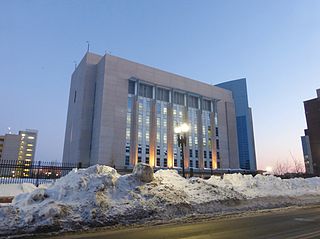
The National Emerging Infectious Diseases Laboratories (NEIDL), is a biosciences facility of Boston University located on Albany street, within the clinical and biopharma hub of the South End neighborhood of Boston, Massachusetts.
As one of the oldest and more historically significant cities in Texas, Galveston has had a long history of advancements and offerings in education, including: the first parochial school (1847), the first medical college (1891), and the first school for nurses (1890).
Avindra "Avi" Nath, is a physician-scientist who specializes in neuroimmunology. Nath is a senior investigator, and intramural clinical director of the National Institute of Neurological Disorders and Stroke (NINDS) at the National Institutes of Health (NIH) in the United States. At NINDS, Nath also leads the Section of Infections of the Nervous System and plans to institute a translational research center. He previously served in several research and administrative positions at the Johns Hopkins Hospital and the Johns Hopkins University School of Medicine.
Rebecca Sealy Hospital was an eight-story hospital, and one of five hospitals on the campus of the University of Texas Medical Branch (UTMB) in Galveston, Texas, United States. It was founded in 1866 as St. Mary's Hospital, a private, Catholic, general hospital, but was purchased in 1996 by the Sealy & Smith Foundation. The foundation renamed it and donated it to the university for use as a psychiatric, outpatient surgery, and research hospital.

Positive pressure personnel suits (PPPS)—or positive pressure protective suits, informally known as "space suits", "moon suits", "blue suits", etc.—are highly specialized, totally encapsulating, industrial protection garments worn only within special biocontainment or maximum containment (BSL-4) laboratory facilities. These facilities research dangerous pathogens which are highly infectious and may have no treatments or vaccines available. These facilities also feature other special equipment and procedures such as airlock entry, quick-drench disinfectant showers, special waste disposal systems, and shower exits.

Texas Energy Engineers, Inc., dba ccrd partners, is a professional engineering firm headquartered in Houston, TX (USA).
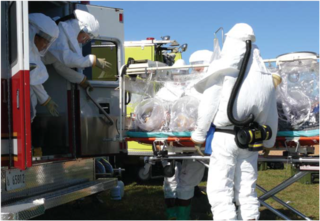
The Aeromedical Isolation Team of the US Army Medical Research Institute of Infectious Diseases (USAMRIID) at Fort Detrick, Maryland was a military rapid response team with worldwide airlift capability designed to safely evacuate and manage contagious patients under high-level (BSL-4) bio-containment conditions. Created in 1978, during its final years the AIT was one of MEDCOM’s Special Medical Augmentation Response Teams comprising a portable containment laboratory along with its transit isolators for patient transport. Contingency missions included bioterrorism scenarios as well as the extraction of scientists with exotic infections from remote sites in foreign countries. The AIT trained continuously and was often put on alert status, but only deployed for “real world” missions four times. The AIT was decommissioned in 2010 and its mission was assumed by one of the US Air Force’s Critical Care Air Transport Teams (CCATTs).
The United States biological defense program—in recent years also called the National Biodefense Strategy—refers to the collective effort by all levels of government, along with private enterprise and other stakeholders, in the United States to carry out biodefense activities.
Peter B. Jahrling is chief of the Emerging Viral Pathogens Section of the National Institute of Allergy and Infectious Diseases.
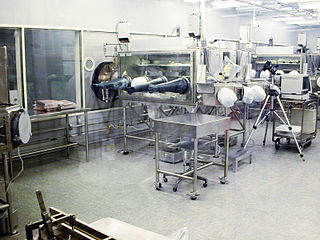
The curation of extraterrestrial samples (astromaterials) obtained by sample-return missions take place at facilities specially designed to preserve both the sample integrity and protect the Earth. Astromaterials are classified as either non-restricted or restricted, depending on the nature of the Solar System body. Non-restricted samples include the Moon, asteroids, comets, solar particles and space dust. Restricted bodies include planets or moons suspected to have either past or present habitable environments to microscopic life, and therefore must be treated as extremely biohazardous.

The Wuhan Institute of Virology, Chinese Academy of Sciences is a research institute on virology administered by the Chinese Academy of Sciences (CAS), which reports to the State Council of the People's Republic of China. The institute is one of nine independent organisations in the Wuhan Branch of the CAS. Located in Jiangxia District, Wuhan, Hubei, it was founded in 1956 and opened mainland China's first biosafety level 4 (BSL-4) laboratory in 2018. The institute has collaborated with the Galveston National Laboratory in the United States, the Centre International de Recherche en Infectiologie in France, and the National Microbiology Laboratory in Canada. The institute has been an active premier research center for the study of coronaviruses.
